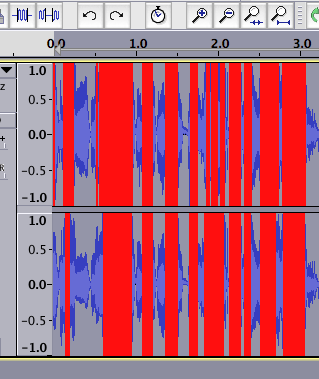I thought I would post this so nobody would make the same mistake.I’ve been Recording with the meter up just before
clipping occurs.And that is too hot.Great for Analog…too hot for Digital.Record no higher than 12db .
The Official Party Line is to record with occasional peaks in the -6dB to -10dB range. That works out to blue wave tips between 50% and 30%.
You can use the Audacity overload tools to see if you’re recording too loud. View > [X] Show Clipping.
If your time line has red bars and lines, you are recording too loud.

Overload and clipping is fatal. It’s where the sound system stops following your show or voice. There is no voice there to rescue. The digital numbering system just runs out of numbers.
You should not go too low, either. If you’re reading for audiobooks, quiet system noise and room noise is down there waiting for you to mess up.
Koz
WARNING: Record between 20-12db
First off, 0dBFS (zero decibels full scale) is the “digital maximum” and so that should be -20 to -12dB. Digital dB levels are generally negative. Acoustic SPL levels are the opposite… 0dB SPL is approximate the threshold of hearing so dB SPL readings are positive.
Those are reasonable good guidelines, especially if you are recording at 24-bits or if you are recording “live” where the peaks are unpredictable. I believe the pro standard is -12 to -18dB. However nothing bad happens when you get close to 0dB, only if you try to go over. Your ADC, DAC, “regular” WAV files, and CDs are all integer-based and hard-limited to 0dB.
With digital recording, your digital levels are not that critical as long as you’re not clipping.
For example, with 16-bits you can hold numbers between minus 32,768 and plus 32,767. If your positive or negative peaks hit those numbers you’ve hit 0dB, and you simply cannot go any higher with integers. (The numbers are bigger with 24-bits, but everything is scaled so it’s not “louder”. There is more resolution with 24-bits and less resolution with 8-bits.)
Audacity uses floating-point internally so it can go over 0dB (but you can’t record over 0dB because your ADC will clip). But for example, you can boost the bass and if that pushes your peaks over 0dB the data won’t clip, but Audacity will show red for potential clipping. This gives you a chance to normalize or otherwise bring the levels down before exporting.
MP3 can also go over 0dB without clipping, and since MP3 is lossy compression it changes the wave shape making some peaks higher and some peaks lower, so if you make an MP3 from a 0dB normalized WAV the resulting MP3 often goes over 0dB. And although the MP3 won’t be clipped, you can clip your DAC if you play it at full-digital volume. For that reason, some people normalize to -1 or -2dB before MP3 encoding.
Recording with the meter up just before clipping occurs. And that is too hot. Great for Analog…
With tape you need a hot signal to overcome tape noise. With digital there is no tape noise and we’ve got a LOT more dynamic range.
The other difference is that tape “soft clips” when you go over 0dB and it can actually go over 0dB so it’s OK to occasionally go slightly “into the red”. Digital hard-clips at exactly 0dB and the ADC can’t go over so you should leave some headroom and NEVER “try” to go over 0dB (unless you’re looking for a clipping “effect”)…
With digital recording, your digital levels are not that critical as long as you’re not clipping.
And as long as you stay digital. The instant you dip into analog land, as with a microphone or other sound adapter, you need to worry about both extremes. Digital overload and the analog noise floor.
Ask anyone who’s tried to pass audiobook standards.
And we shouldn’t completely ignore dithering, either. The tiny noise signal that Audacity adds to the show when translating between bit depths. It’s not good to get too close to that.
Koz
Excellent ! Thank you all for your input !